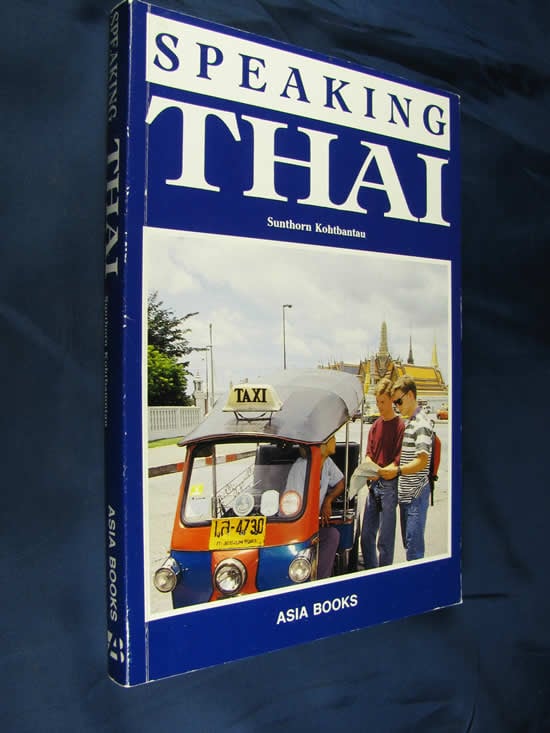I couldn’t find any reviews online for this lesser-known title, so I thought I would give you my own take on it. At first look, this seems like your typical gimmicky language book marketed towards travelers, but it’s actually not that bad. The summary on the back reveals that they didn’t have the highest standards in the world when it came to editing, but I found their mini-introduction rather charming. I will give you the highlights:
“Why not? [...] We will be very proud of you learning our Thai language [...] Anyhow, there are only five tone marks [...] So learn Speaking Thai and start it today [...] great success!”
After reading that, you might be thinking, “Oh gosh, I’ll just skip over this!” but I think that this book can still be useful when put into the hands of the right teacher and/or student.
The introduction clearly states that this book was written with the target audience of “foreigners who speak languages other than Thai”, and the content thus is mainly composed of “various activities that tourists and foreigners are expected to do in Thailand”. Just skimming through the content of the book, it is easy to see that the dialogues and exercises closely follow this idea. With that said, I think that it’s not completely useless if this doesn’t describe you, because much can be learned here aside from how to catch a taxi and order phad thai.

First of all, all Thai language in the book is written first in the native Thai script, below that is a romanization, and below that an English translation. The purists out there may find the romanization a little distracting, but I think it can help by providing a sort of “cheat sheet” for students who have problems reading part the Thai script or want to double check the pronunciation. The English right below makes checking one's comprehension easy as well, but, again, may be distracting to some. In any case, it’s much better than those books that don’t even bother including the native script at all, so I have to give it a couple extra points in this area.
The book does its best to teach you the pronunciation (found in the grammar points of lesson one), but it seems to fall kind of short. There is no IPA (International Phonetic Alphabet) given, and there is no audio available that you can listen along with. It does give you an English parallel of how things are pronounced, along with a guide of their romanization system, but there are no further explanations of how to pronounce each sound. Tones are not explained either, aside from a simple definition. Basically, this means that you have to work with an instructor or use a supplemental source for learning pronunciation, because this book isn’t going to do anything for you.
The basic format of the book is:
· Conversation
· Vocabulary
· Grammar Points
· Exercises
In addition to these, there is a grammar point index and Thai-English glossary at the back of the book.
The conversations are simple and short. While they are strictly focused on simulated interactions between foreigners and Thai people, I found that they were a little more tolerable and a little less lifeless than your average touristy textbook. They include little tidbits of Thai culture, and, while I wouldn’t say that the conversations seem amazingly authentic, you can definitely picture yourself in these kinds of situations having similar interactions. Some people might be put off by the fact that some of the sentences in the dialogues seem short and disjointed, but I found that they still serve their purpose for teaching you a variety of things to be communicated. If I saw the same thing in a Spanish or French textbook, I would probably be a lot more disappointed, but for a language like Thai, which is very different from English, even content like this can prove useful.
"It’s easy to read and doesn’t leave out any of the new terms that were introduced in the conversation - not much more to ask for here."
The vocabulary is given in order of appearance from the conversation (my personal favorite convention), organized in a list with the Thai, romanization, and English. It’s easy to read and doesn’t leave out any of the new terms that were introduced in the conversation - not much more to ask for here.
The grammar points don’t have any long, in depth explanations – just a short sentence or two explaining the point at hand, then several examples following. In most cases I think that this is fine, as there’s no need to drag things out when a concise definition will suffice, but in some cases, users of the book might find they have questions about the grammar that the textbook doesn’t cover. This shouldn't prove to be a problem if working with an instructor, but those studying independently may get frustrated from a lack of depth.
Exercises in this book aren’t really exercises at all. There is just a line that says “Practice reading these words/sentences”, then several words and/or sentences follow. Sometimes the Thai script is not included, which is unfortunate. There is no English translation for any of the exercises in the book, nor is there a key at the back. I don’t really get the point of these “exercises”, but I guess it’s good practice to read some extra sentences and try to find out what they mean for yourself. In a classroom setting, I imagine that an instructor could think of numerous ways to take these sentences and make them into actual exercises (transcribe into Thai script, translate, substitution, etc.)
There doesn’t seem to be any associated audio with this text (at least not as far as I can find), the fonts/layout of the book aren’t particularly appealing, and the content is certainly rough around the edges. However, if you can manage to see past all that, I do think that this could be a nifty little book to check out alongside one or two other introductory books, if just for some extra practice. I give it the rating of usable - there are definitely worse Thai textbooks out there, and you have to give the author credit for the areas that were done well.
For teachers: You could try livening up this textbook by creating exercises as suggested above, or using the content from the lessons to create new dialogues for students to challenge. It would not be difficult for two native speakers create audio recordings of the conversations from the book, which would be a great tool for students.
For students: I would not suggest using this textbook as your first or only means to learn Thai. There are some great Thai books that have been released in the past few years that I would certainly recommend over this one. With that said, using this textbook would be another great way to practice reading and writing Thai using content that will not overwhelm you as a beginner.



